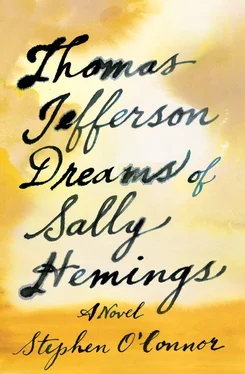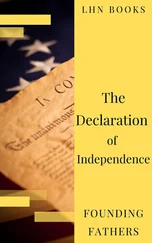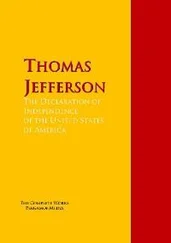Beyond these references, her name, birth year and an account of the food, clothing and bedding she was given at Monticello are noted in Jefferson’s record books, as is the same information about her mother, siblings and children, but not in a way that significantly distinguishes Hemings or her family from any of the other enslaved people who also appear in the record books. We know how much Jefferson paid for her clothing while she was in France and that he boarded her for five weeks with his laundress in the spring of 1789, but we know nothing about the motives or consequences of either of these expenditures. She comes up in two Charlottesville censuses after she left Monticello following Jefferson’s death. In 1830 she and her sons Madison and Eston are classified as white, and in a special 1833 census of black residents of the parish, the family is listed among the “free Negroes & Mulattoes.” And lastly, a 1998 genetic test established that Eston Hemings was the child of a man bearing a Jefferson Y chromosome. The Jefferson family had long maintained that Sally Hemings’s children had been fathered by Thomas Jefferson’s brother or by Peter and/or Samuel Carr, his nephews, all of whom would indeed have had the crucial chromosome, but there is no evidence that these men were ever at Monticello when Hemings’s children were conceived, whereas Jefferson always was — a detail supported by numerous documents.
And that is just about all we have in the way of facts specifically concerning Sally Hemings. While it is hard to imagine that Jefferson would never have mentioned her in a letter during the thirty-seven years of their relationship, the twenty thousand pages of correspondence that he or his white family saw fit to preserve contain not even one clear reference to Hemings — although it is true that the letters he exchanged with his wife, Martha, are also absent from the trove. If Sally Hemings herself ever put a word to paper, it, too, has not survived, though we do have writing by two of her brothers — none of it mentioning her. And although there are dozens of paintings, drawings, etchings and statues of Thomas Jefferson, no image of Sally Hemings taken from life has ever been identified.
While biographers and historians are expected to be rigorously factual, in novels the primary function of fact is to facilitate readers’ suspension of disbelief. Factual accuracy is somewhat more important in realistic novels that purport to represent significant historic or political events, but even so, fiction writers are generally given license to do whatever they want in the gaps between facts. Under such circumstances, the dearth of verifiable information concerning Jefferson and Hemings’s relationship ought to have given me a field day, but, as it happens, Thomas Jefferson presents rather specific challenges to any writer.
With the possible exception of Abraham Lincoln, he is the most written-about and well-documented figure in American history, and his relationship with Sally Hemings has also made him one of the most controversial. I was terribly worried when I first began working on this novel that the sheer volume of information concerning Jefferson would so dominate my thinking that the book would end up as hackneyed and plodding as a dutiful docudrama. And I was even more afraid that the intense political debate regarding his relationship with Hemings (of which I was reminded every single time I told anyone what I was writing) would make it impossible for me to give my characters enough psychological and moral complexity to feel like living, breathing, passionate and perplexed human beings.
The first thing I did when I began to work on this novel was read three biographies: Annette Gordon-Reed’s Hemingses of Monticello , Fawn M. Brodie’s Thomas Jefferson: An Intimate History and Joseph J. Ellis’s American Sphinx. But as soon as I felt I had grasped the basic facts of my protagonists’ lives, I stopped research and leapt straight into writing, composing scenes entirely out of chronological order and switching randomly between realism, fabulism, essay, prose poetry and quotation. My hope was that by never knowing what I was going to write next or how these pieces might link up in the finished work, my mind would be freer to imagine Jefferson and Hemings in fresh and surprising ways and with minimal influence from other people’s narratives or opinions. And, indeed, it was during this phase that Jefferson became an ape, a blimp and an art student in New York and that Sally Hemings created an invention that eventually became the world that Jefferson would have to inhabit. It was also during this phase that I “discovered” my protagonists’ lonely childhoods and the extremity of their passions, be they love, loathing, fury or fear.
Once I had staked out what seemed sufficiently fertile and fresh imaginative territory to guarantee my novel a margin of originality (or so I hoped), I felt free to return to my research. I found two biographies especially useful: Thomas Jefferson: The Art of Power , by Jon Meacham, and Master of the Mountain , by Henry Wiencek — a pair of books that could hardly have diverged more radically in their portrayal of their subject, with Meacham’s Jefferson corresponding fairly closely to the familiar figure of the brilliant if excessively idealistic Founding Father, while the most direct precursor to Wiencek’s Jefferson is Simon Legree — the cruel slaveholder in Uncle Tom’s Cabin . The stark contradiction of these portraits was instructive all on its own, because it helped solidify my sense that Jefferson was an amalgam of opposites — which is not to say that he occupied any sort of bland midpoint between the extremes of virtue and monstrosity but that he was brilliant, idealistic, ignorant and evil all at once. And while I had many problems with Wiencek’s often absurd interpretations of decidedly cherry-picked facts, his book nevertheless forced me to confront Jefferson’s dark side over and over — a process that turned out to be immensely productive.
In addition to these and other biographies, I also read Jefferson’s Autobiography , his most significant political writings (including Notes on the State of Virginia ) and two especially revealing collections of his letters: The Domestic Life of Thomas Jefferson , edited by his great-granddaughter, Sarah N. Randolph, and Jefferson in Love: The Love Letters Between Thomas Jefferson and Maria Cosway , edited by John P. Kaminski. Apart from Annette Gordon-Reed’s masterful account of the whole Hemings family, the book that best helped me envision Sally Hemings’s experience was Incidents in the Life of a Slave Girl , a memoir by Harriet Jacobs, first published in 1861, although I also gathered extremely useful insights and background details from Narrative of the Life of Frederick Douglass (both books are included in The Classic Slave Narratives , edited by Henry Louis Gates Jr.). The brief memoirs by Madison Hemings, Peter Fossett and Isaac Jefferson also deepened my understanding of Hemings, of course, but, more important, they gave me a rich sense of life at Monticello, even if all three of these men clearly allowed their narratives to reflect many of the interests and prejudices of their white interlocutors or readers. And lastly, I visited the places where Jefferson and/or Hemings had lived — Monticello, Poplar Forest, Williamsburg, Philadelphia, London and Paris — and I wrote substantial portions of my novel at the Virginia Center for the Creative Arts, not far from Charlottesville, where I came to have an intimate sense of the smells, sounds, weather and beauties of the Blue Ridge Mountains.
One of the reasons I was so anxious about the effects of the intense political passions regarding Hemings and Jefferson was that I shared those passions to a very considerable extent, especially concerning race and gender. During the early improvisatory phase of my writing, however, I did my best to put such issues out of my mind and just write what seemed most natural and necessary for each individual scene or meditation as it came along. But once I had that first draft, and ever more so as I wrote my final ones, I constantly interrogated myself to be sure that my vision had not been clouded by unconscious prejudice or simple ignorance. I also gave successive drafts to trusted friends — black and white, male and female — and listened carefully to what they said, making corrections where I felt I had misunderstood the reality of the experiences I was trying to render. My goal always was to add depth and specificity to my portrayal of my protagonists, without ever confining them to any preexisting ideas of who they were or what their lives might mean — and I can only hope that I succeeded in this regard.
Читать дальше












